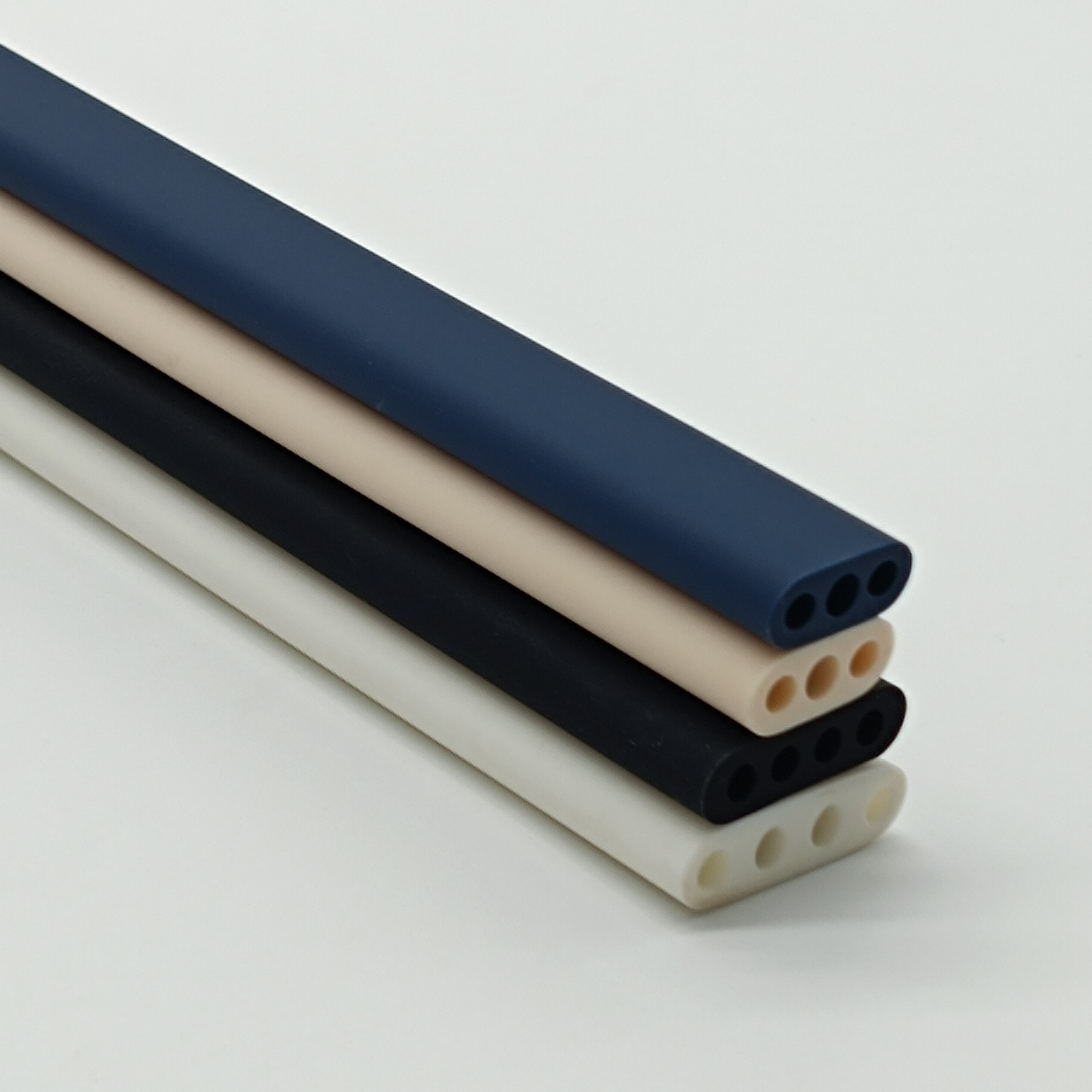Απαραίτητος οδηγός για τη συντήρηση των σκευών μαγειρικής σιλικόνης
Σιλικόνης φόρμες έχουν επαναστατήσει το σύγχρονο ψήσιμο και την αποθήκευση τροφίμων με την πολυμορφία, την ανθεκτικότητα και τις αντικολλητικές τους ιδιότητες. Είτε είστε ένας παθιασμένος νοικοκύρης ζαχαροπλάστης είτε απλώς θέλετε να διατηρήσετε τα βασικά είδη της κουζίνας σας, η σωστή φροντίδα της φόρμας σιλικόνης σας εξασφαλίζει μεγάλη διάρκεια ζωής και άριστη απόδοση. Αυτός ο ολοκληρωμένος οδηγός θα σας περάσει βήμα-βήμα από όλα όσα πρέπει να γνωρίζετε σχετικά με τον καθαρισμό και τη συντήρηση αυτών των καινοτόμων εργαλείων κουζίνας.
Κατανόηση του υλικού της φόρμας σιλικόνης
Ιδιότητες της σιλικόνης για τρόφιμα
Η σιλικόνη για τρόφιμα είναι ένα συνθετικό καουτσούκ που αποτελείται από συνδεδεμένο πυρίτιο, οξυγόνο, άνθρακα και υδρογόνο. Αυτό το εκπληκτικό υλικό μπορεί να αντέξει θερμοκρασίες από την κατάψυξη μέχρι 450°F (232°C), κάνοντας τις φόρμες σιλικόνης ιδανικές τόσο για ψήσιμο όσο και για κατάψυξη. Η μη πορώδης επιφάνεια εμποδίζει την ανάπτυξη βακτηρίων και αντιστέκεται στις λεκέδες, αν και ο σωστός καθαρισμός παραμένει απαραίτητος για τη διατήρηση αυτών των ιδιοτήτων.
Πλεονεκτήματα των σκευών ψησίματος από σιλικόνη
Τα σιλικόνης παρουσιάζουν πολλά πλεονεκτήματα σε σύγκριση με τα παραδοσιακά μεταλλικά ή γυάλινα σκεύη φούρνου. Είναι ελαφριά, εύκαμπτα και φυσικά αντικολλητικά, μειώνοντας την ανάγκη χρήσης ελαίων ή ψεκασμών. Η ανθεκτικότητά τους σημαίνει ότι δεν θα σκουριάσουν, δεν θα ραγίσουν ούτε θα αποκολληθούν όπως τα συμβατικά υλικά. Επιπλέον, η αντοχή τους στη θερμότητα και η ομοιόμορφη διανομή της θερμότητας τα καθιστούν ιδανικά για συνεπείς αποτελέσματα στο φούρνο.
Καθημερινές μέθοδοι καθαρισμού για ταμπέλες σιλικόνης
Βασικές τεχνικές πλύσης
Για τον καθημερινό καθαρισμό, το ζεστό νερό και το ήπιο απορρυπαντικό πιάτων συνήθως επαρκούν. Ξεκινήστε πλένοντας την φόρμα σιλικόνης σας με ζεστό νερό για να αφαιρέσετε τα χαλαρά υπολείμματα. Δημιουργήστε ένα διάλυμα από ζεστό νερό και ήπιο απορρυπαντικό πιάτων, στη συνέχεια χρησιμοποιήστε ένα μαλακό σφουγγάρι ή πανί για να καθαρίσετε όλες τις επιφάνειες, δίνοντας ιδιαίτερη προσοχή σε οποιεσδήποτε υφασμάτινες περιοχές ή γωνίες όπου μπορεί να συγκεντρώνονται υπολείμματα φαγητού. Ξεβγάλτε καλά για να βεβαιωθείτε ότι δεν παραμένει κατάλοιπο σαπουνιού.
Αντιμετώπιση επίμονων υπολειμμάτων
Μερικές φορές τα καμένα φαγητά μπορεί να είναι δύσκολο να αφαιρεθούν. Για πιο δύσκολες περιπτώσεις, μουλιάστε το σιλικόνη φόρμα σε ζεστό, σαπουνόνερο για 15-20 λεπτά πριν τον καθαρισμό. Μπορείτε επίσης να χρησιμοποιήσετε ένα μείγμα σόδας φαγητού και νερού για να φτιάξετε μια πάστα για απαλό τρίψιμο. Αποφύγετε τη χρήση σκληρών σφουγγαριών ή συρμάτινων σφουγγαριών, καθώς αυτά μπορούν να βλάψουν την επιφάνεια της σιλικόνης.
Βαθιά καθαρισμός και απολυμαντική
Αφαίρεση λιπαρών και αποθέσεων λάδιου
Με την πάροδο του χρόνου, τα λάδια μπορούν να δημιουργήσουν μια κολλώδη υπολειμματική ουσία στις φόρμες σιλικόνης. Για να το αντιμετωπίσετε, τοποθετήστε τη φόρμα σε προθερμασμένο φούρνο στους 175°C (350°F) για 10 λεπτά και στη συνέχεια βυθίστε την αμέσως σε ζεστό, σαπουνόνερο. Η θερμότητα βοηθά στη διάσπαση των αποθέσεων λαδιού, καθιστώντας ευκολότερη την αφαίρεσή τους. Εναλλακτικά, μπορείτε να βάλετε τη φόρμα σιλικόνης στο πλυντήριο πιάτων στο πάνω ράφι για έναν ολοκληρωμένο καθαρισμό.
Μέθοδοι απολύμανσης
Για σωστή απολύμανση, μπορείτε να βράσετε το πλακάκι σας από σιλικόνη για 5-10 λεπτά ή να χρησιμοποιήσετε διάλυμα ενός μέρους ξύδι λευκού σε δύο μέρη νερό. Και οι δύο μέθοδοι εξαλείφουν αποτελεσματικά τα βακτήρια χωρίς να βλάψουν το υλικό. Μετά την απολύμανση, βεβαιωθείτε ότι το πλακάκι είναι εντελώς στεγνό πριν το αποθηκεύσετε, για να αποφύγετε προβλήματα από την υγρασία.

Συμβουλές αποθήκευσης και συντήρησης
Ορθές Συνήθειες Αποθήκευσης
Φυλάξτε το πλακάκι από σιλικόνη επίπεδο ή τυλιγμένο για να αποφύγετε μόνιμες πτυχώσεις. Κρατήστε το σε καθαρό, στεγνό μέρος, μακριά από τον άμεσο ηλιακό φωτισμό και πηγές θερμότητας. Αν τοποθετείτε πολλά πλακάκια το ένα πάνω στο άλλο, βάλτε χαρτοπετσέτες ανάμεσά τους για να αποφύγετε το κολλήματα και να διατηρήσετε το σχήμα τους. Αποφύγετε να βάζετε βαριά αντικείμενα πάνω στα πλακάκια από σιλικόνη για να μην παραμορφωθούν.
Προληπτικά Μέτρα Φροντίδας
Για να επεκτείνετε τη διάρκεια ζωής του πλακακιού από σιλικόνη, αποφύγετε τη χρήση αιχμηρών σκευών που θα μπορούσαν να κόψουν ή να γρατζουνίσουν την επιφάνεια. Όταν χρησιμοποιείτε ψεκαστήρες μαγειρικής, εφαρμόστε τους με μέτρο για να αποφύγετε συσσώρευση. Η τακτική επιθεώρηση για ενδείξεις φθοράς ή ζημιάς βοηθά στη διασφάλιση ασφαλούς προετοιμασίας τροφίμων και βέλτιστης απόδοσης.
Κοινά Λάθη που Πρέπει να Αποφύγετε
Απαγορεύσεις Καθαρισμού
Αρκετά συνηθισμένα λάθη μπορούν σημαντικά να μειώσουν τη διάρκεια ζωής του πλαισίου σας από πυριτικό. Αποφύγετε τη χρήση χλωρίου ή ισχυρών χημικών καθαριστικών, καθώς αυτά μπορούν να διασπάσουν το υλικό του πυριτικού. Μην καθαρίζετε με σκληρά σφουγγάρια ή μεταλλικά σφουγγάρια, και μην χρησιμοποιείτε ποτέ γδαρτήρες με άκρη σαν μαχαίρι για να αφαιρέσετε κολλημένα φαγητά. Επιπλέον, αποφύγετε να βάζετε πλαίσια από πυριτικό απευθείας στα μάτια της κουζίνας ή κάτω από το φούρνο.
Σφάλματα Χρήσης
Ενώ τα πλαίσια από πυριτικό είναι εξαιρετικά πολύχρηστα, πρέπει να αποφεύγονται ορισμένες πρακτικές. Μην υπερβαίνετε τη μέγιστη θερμοκρασία που αναφέρεται για το συγκεκριμένο πλαίσιο, και αποφύγετε απότομες αλλαγές θερμοκρασίας που θα μπορούσαν να προκαλέσουν στρέψη. Όταν βγάζετε αντικείμενα από το φούρνο, τοποθετείτε πάντα τα ζεστά πλαίσια από πυριτικό σε επίπεδη, ανθεκτική στη θερμότητα επιφάνεια, αντί να τα βάζετε απευθείας σε κρύες επιφάνειες.
Συχνές Ερωτήσεις
Μπορούν τα πλαίσια από πυριτικό να μπουν στο πλυντήριο πιάτων;
Ναι, τα περισσότερα πλαίσια από πυριτικό είναι κατάλληλα για πλυντήριο πιάτων. Τοποθετήστε τα στο πάνω ράφι για καλύτερα αποτελέσματα, αλλά ελέγξτε πρώτα τις οδηγίες του κατασκευαστή, καθώς μερικά συγκεκριμένα προϊόντα μπορεί να έχουν διαφορετικές συστάσεις.
Πώς μπορώ να αφαιρέσω επίμονες οσμές φαγητού από το σιλικόνη φόρμα;
Για να εξαλείψετε επίμονες οσμές, δοκιμάστε να ψήσετε την άδεια φόρμα στους 175°C για 20 λεπτά, και στη συνέχεια πλύνετέ την όπως συνήθως. Εναλλακτικά, φτιάξτε μια πάστα με σόδα για ψήσιμο και νερό, απλώστε την στην επιφάνεια, αφήστε τη να μείνει για αρκετές ώρες και στη συνέχεια πλύνετέ την προσεκτικά.
Πόσο χρόνο θα πρέπει να διαρκεί μια φόρμα σιλικόνης με σωστή φροντίδα;
Με σωστή φροντίδα και συντήρηση, μια φόρμα σιλικόνης υψηλής ποιότητας μπορεί να διαρκέσει 3-5 χρόνια ή και περισσότερο. Κανονικός καθαρισμός, κατάλληλη αποθήκευση και η αποφυγή βλαπτικών πρακτικών θα βοηθήσουν στη μεγιστοποίηση της διάρκειας ζωής της.
